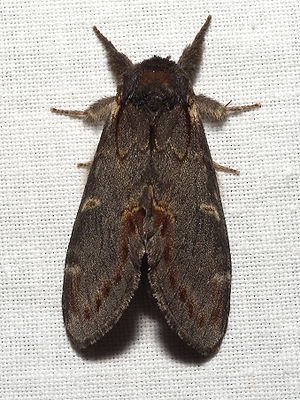Dromedary tooth spinner
| Dromedary tooth spinner | ||||||||||||
|---|---|---|---|---|---|---|---|---|---|---|---|---|

Dromedary tooth spinner ( Notodonta dromedarius ) |
||||||||||||
| Systematics | ||||||||||||
|
||||||||||||
| Scientific name | ||||||||||||
| Notodonta dromedarius | ||||||||||||
| ( Linnaeus , 1767) |
The dromedary tooth spinner or alder tooth spinner ( Notodonta dromedarius ) is a butterfly ( moth ) from the family of tooth spinners (Notodontidae).
features
The moths reach a wingspan of 35 to 45 millimeters. They have gray forewings with rust-brown and yellowish spots and dark serrated bands. An interrupted rust-brown band runs along the outer edge of the forewing. The hind wings are colored light gray.
The caterpillars are approx. 38 millimeters long and are colored yellow on the upper side, tapering down into green. They are rarely olive and gray-brown. They have pointed back humps on the fourth to the seventh and the eleventh segment, which, with the exception of the eleventh, are colored white with a red-brown border on the tips. There are three red stripes on the back, which sometimes flow together to form a broad central stripe. They also have red side stripes on the sides above the legs. The stigmas are black-gray or yellowish with a dark mark.
Occurrence
The animals are found in Europe and Asia Minor and live in dry as well as in wet areas with stocks of their forage plants, such as on the edges of forests , in alluvial forests , moors and on heaths , but also in parks. They are common.
Way of life
The nocturnal moths, especially the males, are easily attracted by artificial light at night.
Flight and caterpillar times
The species flies in two generations per year from mid-May to June and from late July to late August. The caterpillars from the eggs of the first generation are found from August to September, those of the second in June and July of the following year. Only one generation flies in the mountains from June to July.
Food of the caterpillars
The caterpillars feed on the leaves of the silver birch ( Betula pendula ) and black alder ( Alnus glutinosa ), rarely also on the quivering aspen ( Populus tremula ), willow ( Salix caprea ) and common hazel ( Corylus avellana ).
development
The caterpillars pupate in a web on or in the ground. The doll is colored black-brown. The second generation pupae overwinter.
credentials
literature
- Heiko Bellmann : The new Kosmos butterfly guide. Butterflies, caterpillars and forage plants. Franckh-Kosmos, Stuttgart 2003, ISBN 3-440-09330-1 .
- Karl Cleve: An obscured form of Notodonta dromedarius L. from East Holstein. In: Communications of the Faunistic Working Group for Schleswig-Holstein, Hamburg and Lübeck. 12th year, 1959, issue 2, ZDB -ID 205976-9 .
- Hans-Josef Weidemann, Jochen Köhler: Moths. Weirdos and hawkers. Naturbuch-Verlag, Augsburg 1996, ISBN 3-89440-128-1 .
Individual evidence
- ↑ Manfred Koch : We identify butterflies. Volume 2: Bears, Spinners, Swarmers and Drills in Germany. 2nd, expanded edition. Neumann, Radebeul / Berlin 1964, DNB 452481929 , p. 114 f.
Web links
- Lepiforum e. V. Taxonomy and Photos
- www.schmetterling-raupe.de
- Moths and Butterflies of Europe and North Africa (English)
- Ian Kimber: Guide to the moths of Great Britain and Ireland (English)
- Notodonta dromedarius in Fauna Europaea



